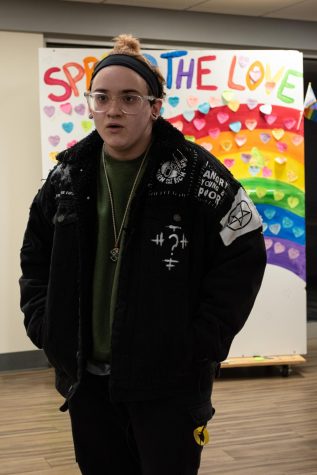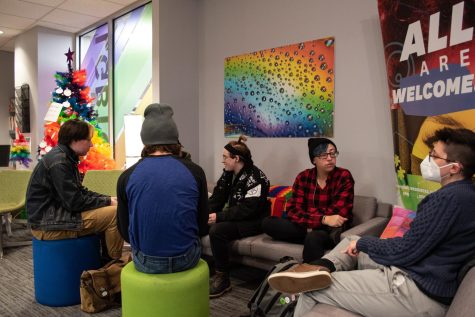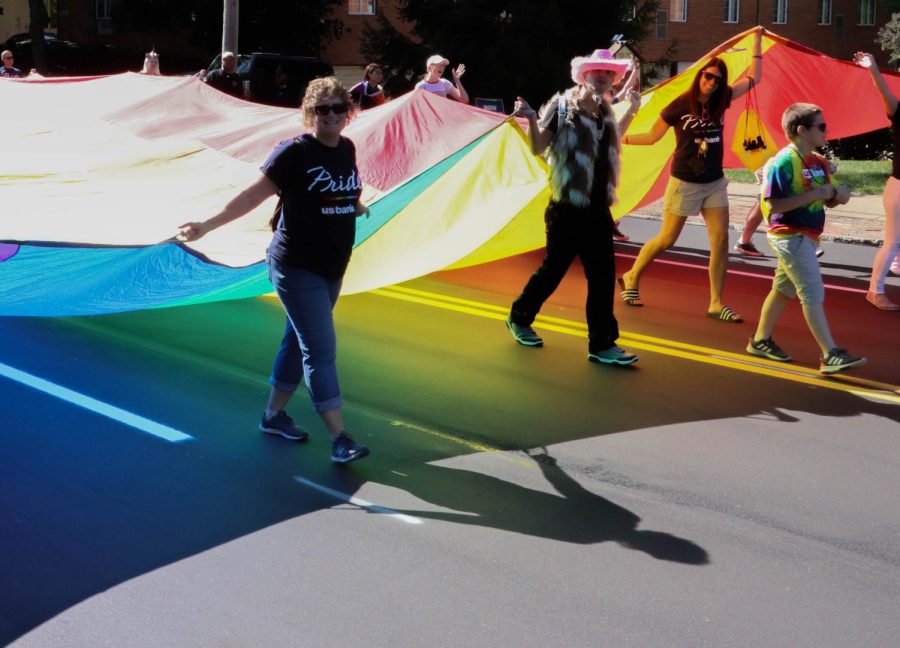OPINION: We need more queer safe spaces
A dance to remember
A group of people walking in the parade carry a giant LGBTQ+ flag down the middle of the street in a pride parade in Akron, Ohio on Aug. 24, 2019.
I spent the summer in San Francisco, a city known for its picturesque views and its trendy population. They have the Golden Gate Bridge, the Sushirrito, the historically hilly roads, the hippie revolution. I was excited to be there, and I had my priorities set.
Priority number one: excel at my first big-time internship. Priority number two: explore as much of the Bay Area as I could in 12 weeks.
When the weekend would roll around, my friends and I would hit the clubs. As I prepped for a night out, I had my concerns. I pored over my closet trying to decide which outfit I should wear. I concocted the perfect cocktail of alcohol to ensure a good buzz but not enough to make the walk home difficult. I checked to make sure I had enough cash for cover fees and tipping the bartenders. I wondered if the pizza place on the corner would be open after midnight.
My parents had their concerns too. Was I walking home from the bus station alone? Was I always watching my drink?
When I went to Pride, my mother worried about the possibility of homophobic protestors getting violent.
But for me, being surrounded by my community, I was the safest I could be.
San Francisco Pride is the largest Pride celebration in America, bringing in nearly 1 million people each year. This was the first Pride weekend I was to attend, and I was ecstatic. My weekend itinerary was packed: a brunch, a big parade, a day out in the sun and a night at the lesbian bars.
My first Pride was filled with so much joy. What is so magical about Pride is there are queer people everywhere in the city. And you’re probably thinking, “Duh, it’s Pride,” but I had never seen so much queerness in one space. It’s so different from my curated TikTok feed of a nonbinary person who turns carousel horses into disco balls and clips of a queer couple’s wedding vows. I felt so lucky to be surrounded not only by queer people I loved but by queer people I didn’t even know.

Even outside of the pomp of Pride, I felt so at home in the San Francisco community. It was the little things – rainbow flags in storefront windows, a cashier with a Steven Universe t-shirt, a queer couple holding hands. But it was also being surrounded by a rich queer history.
San Francisco is where Harvey Milk, the first openly gay man to be a public official, asked Gilbert Baker to create a symbol for the gay community – what became the eight-stripe rainbow flag. San Francisco is where Cleve Jones made the 54-ton AIDS memorial quilt. San Francisco is the home of the Castro, one of the first gay neighborhoods in America.
The thing about being in the Castro in 2022 is the bars are geared toward white, cis-gay men. As a Black trans person who is more femme presenting at times, I stuck out like a sore thumb. It wasn’t always the most affirming space (I’ll get into that later), but most nights I didn’t mind it. The boys would compliment me on my style, and I felt safe because they weren’t making a pass at me. And I danced and danced and danced.
When I awoke on Sunday, November 20, I opened my phone to Instagram, just like any other morning. And the first posts I saw were of news rolling in about a shooting at Club Q, a queer nightclub in Colorado Springs. Five killed. Nineteen Injured.
My initial thought, however morbid, was that I was not shocked. I was disappointed. I was sad. I was hurt. But I was not surprised. We’d been through this before.
As someone who is Black and queer, I am familiar with community grief. It taunts me. It haunts me in broad daylight. As I am enjoying the privileges of being an out-and-proud person in the 21st century, I mourn the queer elders I never had the chance to know. I am angered by the knowledge that I may not know peace in my lifetime.
Two weeks later, I attended a candlelight vigil in support of Club Q. It was 35 degrees outside, and the sun had already set. The wind held strong and loud as the person leading the vigil began to speak at the podium. I held a candle in my frozen fingers as the speaker asked us to recite the names of the victims of the Club Q shooting.
I was disappointed in myself for not knowing their names by heart.

Kelly Loving.
Daniel Aston.
Derrick Rump.
Ashley Paugh.
Raymond Green Vance.
It gets overwhelming when names are added to the list of those taken from us. This year we have lost 35 transgender people to violence, and they are the people who have been accounted for.
Where do I go from here? How do I find community when everything is crashing around us?
In December, I had the pleasure of attending a birthday party for a friend — a fellow Black and queer person. Prior to the party, I sat in my room hyping myself up. I tend to get a bit anxious before going to a party, so I told myself that I only had to stay for an hour and then I could go home.
But, when I walked through the front door, I instantly felt at home.
The guests were all queer people, most also people of color. The conversation flowed — we talked about our tragic exes and laughed about our parents’ homophobic tendencies. We played Jenga and Cards Against Humanity. We danced to Beyonce’s “Renaissance” in the kitchen. I stayed until the party died down four hours later.
Being in their home was so much more affirming than being in the club with a crowd of white cis gay men because I was in the company of people who understood my experience as a queer person. Going to school in Ohio, these opportunities are few and far between. Living in America, these opportunities are few and far between.
There are only 27 lesbian bars in the United States.
I want more lesbian bars. I want more nightclubs and more community centers and more bookstores and more bakeries. Queer people want more safe spaces.
How do we construct them?
The plan needs to be two-fold. As queer people, we have to seek each other out and create opportunities to connect. We need to participate in mutual aid and build up the people and places we care about. We need to continue fighting for our rights day in and day out, no matter how tired we are. But we also need allies to work alongside us. We need people to recognize that there is still work to be done in combatting homophobia in America.
And until then, we will not be able to go dancing without our mothers wondering if we’ll make it home that night.
Reegan Saunders is opinion editor. Contact him at [email protected].
Reegan(they/he) is a senior journalism major with a minor in print media & photography. As a writer, they focus on the Black and queer experiences,...
Matthew is a junior photography major. He has a passion for photography and traveling.
Contact him at [email protected].



















Bashi Saunders • Jan 16, 2023 at 9:20 pm
yaaaaass all of this! well written!